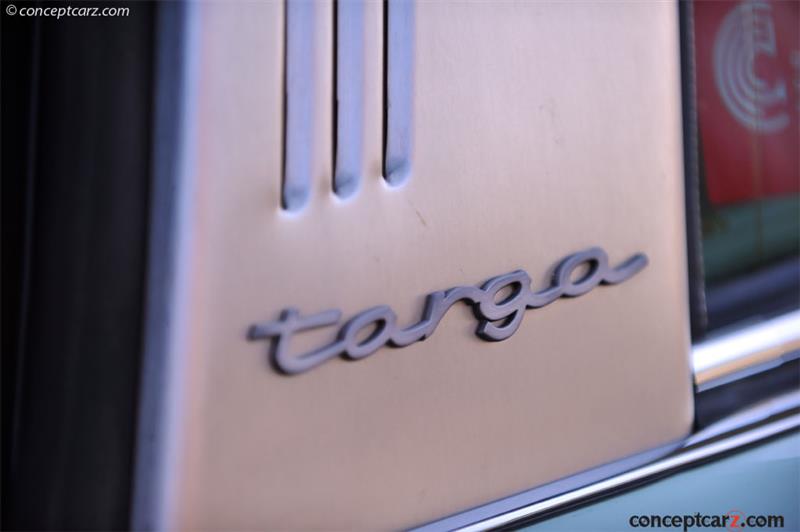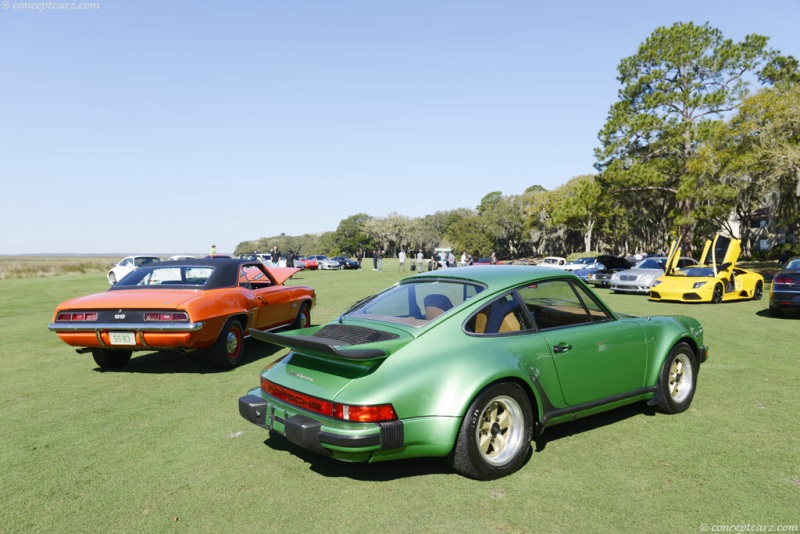The first of many upgrades to the Porsche 911 came in 1966 with the introduction of the 911S. The 'S' featured a modified engine developing 160 horsepower and was externally distinguishable by its Fuchs five-spoke alloy wheels. In 1969 the wheelbase was lengthened resulting in improvements to its handling. In 1970 the air-cooled 'flat-six' underwent the first of many enlargements - to 2.2 liters. In 1974 all Porsche 911 variants were fitted with the 2.7-liter unit, hitherto reserved for the Carrera when the latter went to 3.0 liters. The non-Carrera tuned 2.7-liter unit offered 175 bhp which was slightly less power than the previous '2.4,' but developed significantly more torque over a much wider rev range which greatly improved acceleration. When fed with low-lead petrol, and having an increased tank capacity, the new 911 was superior to its predecessor in every way as a high performance, long-distance tourer. The Coupe version was introduced in 1964 followed two years later by a convertible 911 known as the 'Targa,' named in recognition of Porsche's numerous victories in the Sicilian classic. In compliance with U.S. safety legislation, the soft-top 911 received a hefty roll-over bar to protect the occupants in the event of an inversion, together with removable roof and rear hood sections, which were stowed in the boot. A few years later, in 1969, a quieter and less leak-prone fixed rear window replaced the rear hood, and the Targa would continue in this guise well into the 1990s, receiving numerous mechanical and styling developments along the way.
1976 Porsche 911
The 1976 Porsche 911S was powered by a horizontally opposed, overhead-cam six-cylinder engine displacing 163.9 cubic-inches and offering nearly 160 horsepower. It came standard with a five-speed manual gearbox for US destined cars. The European models had a four-speed. It was available as a two-door coupe or as a Targa. Pricing began at $13,850. Few changes were given to the 1976 911S with the exception of additional standard equipment, including intermittent wipers and tinted glass.Carrera
In 1973, Porsche revived the evocative 'Carrera' name for its top-of-the-line 911. Designated 'Carrera RS' (for RenSport), it was a limited edition product for Group 4 GT racing, a class that required a minimum of 500 examples built. Demand was so strong that the production run was later progressively extended, ending up at 1,590 units. Handling was improved by the revised suspension and wider wheels, while the 2.7-liter, Bosch mechanically fuel-injected, 210 horsepower engine provided a top speed of nearly 150 mph. In the autumn of 1975, the next major development arrived - a 3.0-liter engine derived from the Type 930 Turbo. The 3.0-liter Carrera existence was brief, ending in 1978 when the 911 range was upgraded to 'SC' specification. This marked an important development in the production process of the 911, with the adoption of Thyssen anti-corrosion zinc coating for the steel body panels. The previous 11-blade cooling fan was replaced by a new five-blade unit which ran faster to improve alternator output. In total, Porsche produced 3,687 examples of the 3.0-liter Carreras.
by Daniel Vaughan | Dec 2011
1976 Porsche 911
The 1976 Porsche 911S was powered by a horizontally opposed, overhead-cam six-cylinder engine displacing 163.9 cubic-inches and offering nearly 160 horsepower. It came standard with a five-speed manual gearbox for US destined cars. The European models had a four-speed. It was available as a two-door coupe or as a Targa. Pricing began at $13,850. Few changes were given to the 1976 911S with the exception of additional standard equipment, including intermittent wipers and tinted glass.Carrera
In 1973, Porsche revived the evocative 'Carrera' name for its top-of-the-line 911. Designated 'Carrera RS' (for RenSport), it was a limited edition product for Group 4 GT racing, a class that required a minimum of 500 examples built. Demand was so strong that the production run was later progressively extended, ending up at 1,590 units. Handling was improved by the revised suspension and wider wheels, while the 2.7-liter, Bosch mechanically fuel-injected, 210 horsepower engine provided a top speed of nearly 150 mph. In the autumn of 1975, the next major development arrived - a 3.0-liter engine derived from the Type 930 Turbo. The 3.0-liter Carrera existence was brief, ending in 1978 when the 911 range was upgraded to 'SC' specification. This marked an important development in the production process of the 911, with the adoption of Thyssen anti-corrosion zinc coating for the steel body panels. The previous 11-blade cooling fan was replaced by a new five-blade unit which ran faster to improve alternator output. In total, Porsche produced 3,687 examples of the 3.0-liter Carreras.
by Daniel Vaughan | Dec 2011
Related Reading : Porsche 911 History
The legendary Porsche 911 is the longest production run sports car of all time. It was conceived as a successor for the highly successful Porsche 356 and from the start had high aspirations for success. Ferry Porsches son, Ferdinand Alexander Porsche, designed the 911. When it went into production it was labeled the 901 but Peugeot had claims to the name, so to avoid infringing on their naming scheme,....
Continue Reading >>
Continue Reading >>
Related Reading : Porsche 911 History
Who could predict that the 911 would be Porsches saving grace and surpass the 356 in sales, longevity Quickly establishing itself as an icon of 60s cool, the iconic 911 only became more popular as the years went on. The flagship of the current lineup of Porsche, the 911 (pronounced Nine Eleven) or Neunelfer is a two-door grand tourer with a very distinctive design. The 911 is one of the oldest....
Continue Reading >>
Continue Reading >>
Similar Automakers
Similarly Sized Vehicles
from 1976
1976 Porsche 911 Vehicle Profiles
Recent Vehicle Additions
Performance and Specification Comparison
Price Comparison
$7,260
$9,390
$10,845
$25,855
G, H, I and J series - 2.7-litre Specification Comparison by Year
Year
Production
Wheelbase
Engine
Prices
Related Automotive News

Gooding & Company Gears Up for Its 2023 Amelia Island Auction with RUF//The Collection
The auction house has announced RUFThe Collection, a set of four exciting RUF automobiles, including a 1998 RUF Turbo R, a 1998 RUF Turbo R Cabriolet, a 1997 RUF BTR2, and a 2007 RUF RK Coupe, to lead its 2023 Amelia Island Auction.
...

911 Carrera RS 2.7 Headlines Silverstone Auctions' Autosport Debut
Rare, first series 1973 Porsche 911 Carrera RS 2.7 for auction
Restored by award-winning approved Porsche body shop, Premier Panel Skills
Estimated at £340,000 to £380,000 at the Autosport International Sale
A rare, first series Porsche 911 Carre...
2016 MAZDA LINEUP: WHAT'S NEW
Having launched two refreshed and two all-new models for the 2016 model year, Mazda North American Operations is keeping busy with broadening its award-winning lineup of cars and crossovers. For the 2016 model year, Mazda is keen to maintain its leadership...
2015 SUBARU XV CROSSTREK AND XV CROSSTREK HYBRID GET NEW INFOTAINMENT AND SAFETY TECHNOLOGIES
Subaru-developed driver assist technology, EyeSight® now available on XV Crosstrek
EyeSight-equipped vehicles also add Steering Responsive fog lights standard
New 6.2-inch infotainment system with rear vision camera standard on 2.0i, 2.0i Premium...
MODEL YEAR 2015: NEW GOLF FAMILY, REDESIGNED JETTA, AND NEW TDI® CLEAN DIESEL ENGINE HEAD THE CHANGES
In a busy year, Volkswagen will also add a new Golf SportWagen, an all-new Golf R, a redesigned Touareg SUV, and the companys first U.S.-market EV, the e-Golf
All-new Golf is bigger, lighter, and more fuel-efficient than the previous model,...

































